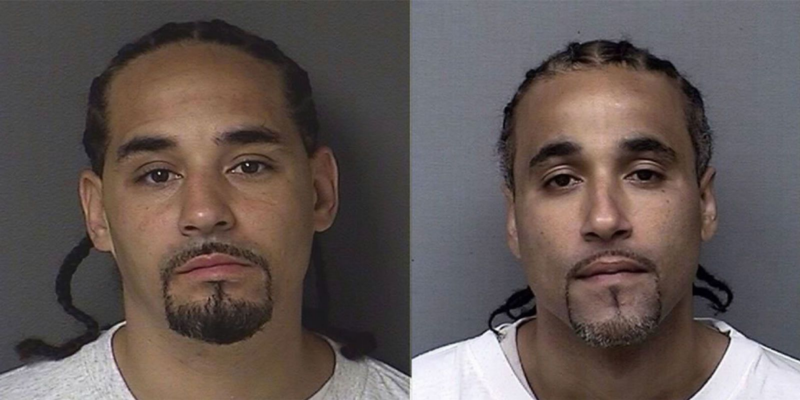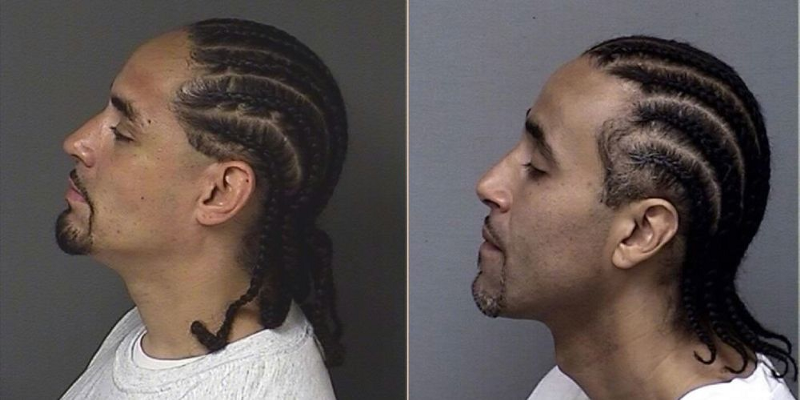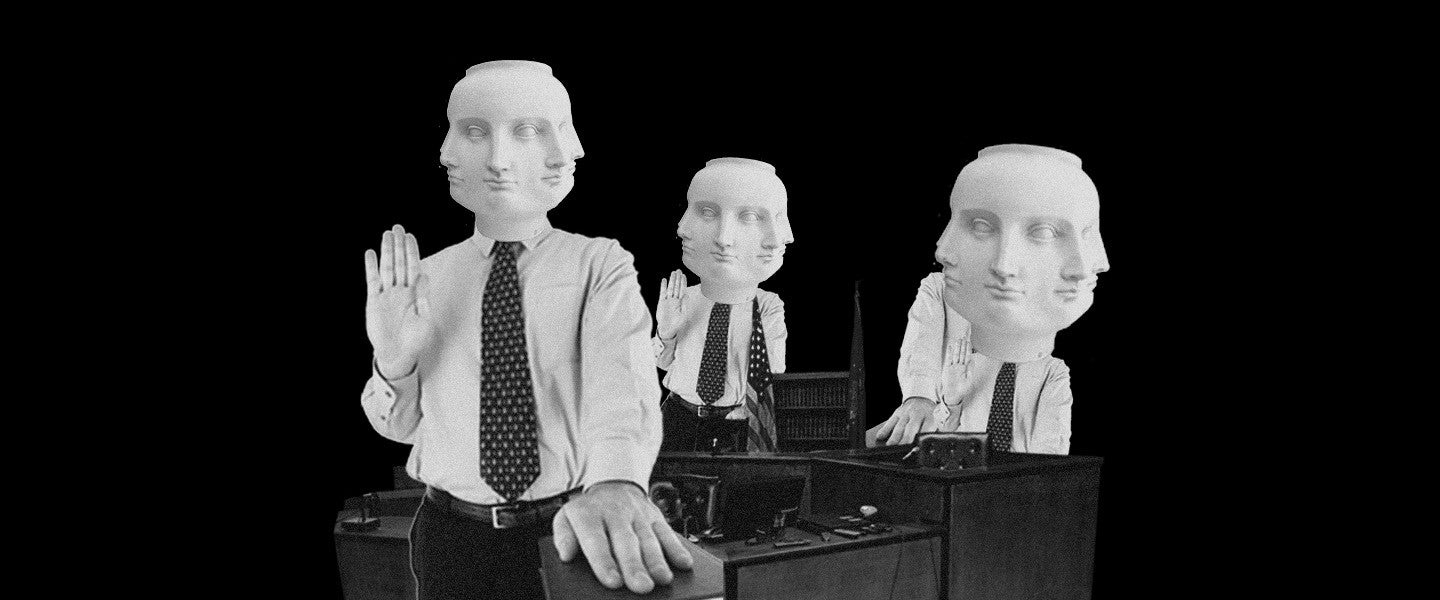Manny Balestrero should have never walked into that life insurance office. But on January 14, 1953, he did, looking to borrow $325 from his wife’s policy in order to pay for some critical dental work she needed. The next night, as he unlocked the door of his modest stucco home in Queens, he heard a voice from behind him. “Hey, Chris!” a man called out, referring to him by his formal first name.
Balestrero turned and spotted three police officers. They were detectives, and they were adamant that Balestrero needed to come with them, as he was suspected to be a serial robber who was hitting targets all over Queens. Balestrero had no idea what to say — he was a bass player at the Stork Club, happily married if struggling a bit financially. Yet as the detectives toured him through a string of Queens liquor shops, drugstores and delis, as well as that Prudential life insurance office, a string of witnesses confidently proclaimed him as the culprit.
Balestrero’s real-life mix up with a doppelganger is the subject of Alfred Hitchcock’s 1956 docu-drama The Wrong Man, which has a happy ending of sorts: Balestrero was eventually exonerated when the police found and arrested the real culprit in the middle of another robbery. Claiming that someone who looks like you committed the crime is a gambit as old as our criminal justice system — and one that more often than not falls flat. But in this case, it turned out to be true.
It’s basically an extension of the misidentification defense, where you argue that the victim or eyewitnesses involved aren’t remembering the incident correctly or with enough precision. With a doppelganger defense, though, the defendant is basically saying that the people who claim it was them did remember the face of the assailant correctly — but that it wasn’t their own.
The phrase has hit mainstream consciousness thanks to Brett Kavanaugh, the Supreme Court nominee currently mired in controversy over his alleged sexual assault of schoolmate Christine Ford when he was 17 and she was 15. Ford has testified that she was attacked by Kavanaugh at a house party in July 1982, where the alcohol was flowing amid people she either knew or knew of. She says a “stumbling drunk” Kavanaugh cornered her in a room, climbed on top of her, and attempted to tear her clothing off while holding his hand over her mouth, all the while groping her. “I thought he might inadvertently kill me,” Ford told The Washington Post.
Kavanaugh, in response, has been adamant about his complete innocence. “I am not questioning and have not questioned that perhaps Dr. Ford at some point in her life was sexually assaulted by someone at some place, but what I know is I’ve never sexually assaulted anyone,” he said in a Fox News interview.
Along those lines, conservative activist Ed Whelan attempted to come to Kavanaugh’s rescue with a hypothesis that a classmate of Kavanaugh’s, who he claimed looked similar, had been the culprit — even doxxing the man with a tweet revealing his full name and home address, among other details. Whelan quickly realized this was a mistake (and possibly libel), but the theory spread rapidly across the digital seas of the right-wing.
For her part, Ford has been adamant that she would “never” mix up Kavanaugh’s face with another’s. And while misidentifications plague the criminal justice system generally, the real-life “doppelganger defense” is more rare and challenging to prove than people assume, says Peter Johnson, a lawyer and criminal defense expert who lectures at UCLA. “The accused needs a good alibi, and if the alibi is bad, then who was it? The burden isn’t supposed to be on the defendant with that question, but in practice, of course they’re confronted with that,” he explains. “When a defendant claims it was someone else in the face of other credible evidence, it requires additional investigation. Most people with power and money can explore that defense.”
Kavanaugh and Ford obviously aren’t in a formal trial process, just a rapid FBI background investigation — one that many legal experts think falls short, given the agency has no ability to subpoena information from relevant players. But what do the incredibly rare proven cases of doppelganger crime actually tell us about the claim that Ford is simply misremembering the person behind the face? As it turns out, there’s a reason why such instances are so uncommon. A review of three publicized mix-ups shows that while they’re complicated crimes, the factors that fueled them are extremely distinct from what Kavanaugh’s defenders can claim.
The Time an Innocent Man Served 17 Years
A 2015 study found that the likelihood of having a real-life doppelganger, with facial features in all the right proportions, is a one-in-a-trillion shot. Yet look at a photo of Kansas City resident Richard Jones and his criminal doppelganger, and you’d be hard-pressed to call them anything but doppelgangers. They both have caramel-hued skin, neat braids of black hair and the same trimmed goatee. Even their eyes sport the same downward turn and folded eyelids.


Jones found his doppelganger while stuck behind bars for a robbery he didn’t commit in 1999. He kept hearing from inmates that another man who had served time looked just like him, and even shared the same first name. Jones wanted to do anything to cut his 19-year sentence short, so he reached out to the Midwest Innocence Project, pleading for legal help. A pro-bono team tracked the other man, named “Ricky” Amos, down. He lived near the site of the robbery, in Rowland Park, Kansas, whereas Jones lived in Missouri at the time. “When I saw his picture, it just made sense to me,” Jones told the Kansas City Star. “They say you can’t see the picture clearly if you [are] in it, but if I was outside this picture I would have seen the same thing.”
The cops never found any DNA evidence, but they hunted down Jones months after the robbery thanks to the testimony of a man who admitted that he’d only met Jones once (while high on drugs, to boot). It didn’t matter much to the jury, which was convinced by the fact that witnesses and the robbery victim had picked Jones out of a photo lineup. “There’s an element of laziness by prosecution and police, where once someone identifies a suspect in a photo, it’s like, ‘Hey, all is good, the jury is going to believe us,’” says UCLA’s Johnson. “More pre-trial investigation could have prevented this.”
When the two witnesses, victim and prosecutor were shown side-by-side photos of Amos and Jones last summer, no one could tell them apart. After hearing an appeal, a judge ordered Jones be set free in June 2017, though he had served all but two years of his sentence. A thin silver lining is that people from around the internet raised more than $25,000 for him to get a new start as a free man.
The Time the Best-Friend Lookalike (Maybe) Pulled the Trigger
A May 2009 case seemed pretty open-and-shut to San Francisco prosecutors: Detectives had recovered a phone from the scene of a shooting at Visitacion Valley, where 19-year-old Eric Campos lay dead from a bullet to the head. The phone belonged to 16-year-old Orlando Ware, and a quick call search showed that he’d phoned Campos just hours before the killing, likely for a drug deal.
The cops arrested Ware, but soon realized that a second man had been at the scene. It didn’t take much sleuthing to realize it was Ward’s closest friend. They were both lanky black kids with braids, and they’d worn matching puffy jackets with diamond stitching while meeting Campos. Law enforcement speculated that Campos was chasing after Ward and his friend over stolen goods when Ward turned to shoot him down.
But some of the findings threw them for a loop. In the pocket of the friend’s jacket, investigators found the weed and ecstasy they believed had been stolen from the victim. And both puffy jackets tested positive for gunpowder. Nonetheless, prosecutors on the case pushed forward with Ward’s cell phone as the lone piece of physical evidence, and delved into his background for context. Ward was just 15 when he caught his first offense, as an accessory to a robbery of a 23-year-old woman in San Francisco in July 2006. He got a lucky break, given that he was released on probation with conditions that he obey a curfew, seek counseling and not skip school.
Over the next 10 months, he broke probation multiple times, ultimately turning himself into a juvenile detention facility after a bad gunfight with a rival gang. In another lucky break, just days after he was booked, then San Francisco Mayor Gavin Newsom announced an early-release program for qualifying incarcerated juveniles. Ward walked free and eight days later killed Campos, prosecutors said.
Perhaps the prosecution thought the jury would be swayed by this record, and Ward’s story did spark debates about whether or not criminal justice reforms were too lenient. In the end, however, a lack of convincing evidence and the unwillingness of the prosecution to thoroughly consider the doppelganger accomplice led to a not-guilty verdict.
The Time the Doppelganger Was Executed
Carlos DeLuna was executed in 1989 for the murder of 24-year-old Wanda Lopez, a gas station attendant in Corpus Christi, Texas. Until his dying day, DeLuna claimed that his doppelganger, a man in Corpus Christi named Carlos Hernandez, had been the one to stab her.
The attack happened on the night of February 4, 1983, and reports were convoluted from the moment the first 911 calls came through. One witness inside the gas station store claimed the attacker wore a flannel shirt; another from the street identified a man in a white dress shirt. Simultaneous reports had the suspect running both north and east after the stabbing. Later that night, police found DeLuna hiding under a pickup truck in a puddle of water, missing a shirt but with a wad of $149 in his pocket. The crime scene was “incredibly bloody,” as one police report noted, and witnesses claimed the killer had struggled with Lopez, but no blood was found on DeLuna’s shoes or pants. A white shirt found two days later, purportedly the one that DeLuna ditched, also showed no blood.
Things got more bizarre in trial. DeLuna claimed that Hernandez appeared out of the blue to say “hello” while he was hanging out with his two sisters earlier on February 4. He recognized Hernandez as someone from his childhood, and proposed going out for a drink at a nearby bar to catch up. Amid rounds of beer, Hernandez got up to grab something from the gas station across the street. That’s when DeLuna claims he witnessed the man attacking Lopez. In a panic, he walked out of the bar and began running when he heard sirens, he testified.
The problem was that DeLuna was the opposite of a reliable narrator. His alibi had holes — one of the two sisters was at a baby shower, and he lied to his parole officer that day about where he was. He also had two attempted violent rapes on his record, which made jurors fixate on his penchant for violence against women. Police didn’t investigate the doppelganger, Hernandez, because DeLuna refused to pick out his mugshot from a database of men with the same name in Corpus Christi. He never explained why.
But 2006 and 2012 reviews from the Chicago Tribune and Columbia Law School found major evidence of discrepancies in the murder trial. The Columbia team specifically found Hernandez had a history of robbing gas stations and assaulting women with knifes. They also found friends and acquaintances of Hernandez who claimed he had bragged to them about killing Lopez and watching DeLuna take the blame. In fact, he later served 19 months in prison for stabbing another local woman with a knife nearly identical to the one used to kill Lopez.
Even DeLuna’s lawyers didn’t know what to make of the case, with one speculating that perhaps DeLuna and Hernandez were in it together. Another lawyer suggested that DeLuna feared snitching on Hernandez, who ultimately died of cirrhosis while in prison in 1999. But the victim’s family appears to believe DeLuna’s side, with Lopez’s brother releasing a statement in 2006 that read in part, “I am convinced that Carlos DeLuna did not kill my sister and that Carlos Hernandez was the real murderer.”
These three cases, as well as the tale of Manny Balestrero, show us that though some men have become entangled with a lookalike criminal, the context around it is critical and unique. While victims and eyewitnesses misidentifying suspects remains a major issue for law enforcement and the courts, the vast majority of these instances deal with strangers or unfamiliar environments. In other words, doppelganger defenses are strong when there’s too little consistent information; they often crumble when time is spent to understand each person’s background and motives (and when the victim knows the perpetrator).
The critics of Christine Ford suggest that, as with unreliable witnesses, she’s misremembering the evening. Yet that ignores the differences between having to recall the face of an attacker you’ve never seen before and that of acquaintances like Kavanaugh and his friend Mark Judge, whom Ford says was in the room, laughing loudly at Kavanaugh’s attempt at raping her.
It’s true that Ford admits she can’t remember some details of the night, including how she got home, which her detractors have seized upon. But she and others have painted a precise, unflinching portrait of a young Kavanaugh, with additional reporting (on his friends and activities) that explain why he could have been in that bedroom with her. This is also consistent with expert opinions on how stress cements certain traumatic memories and not other, more banal ones. It’s also, given the topic at hand, inconsistent with the doppelganger theory.
“Without getting into who did what exactly, I can’t say that it makes sense,” UCLA’s Johnson says of the assertion that a lookalike assaulted Ford. “It sounds clearly like Dr. Ford knew him in advance. This isn’t really how misidentification works in wrongful convictions, and the doppelganger defense wouldn’t actually apply, I think.”

